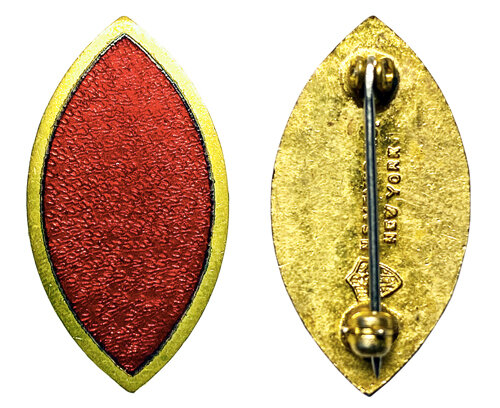History of the 44th Infantry Regiment (PS) Insignia
By Sean Conejos
Figure 1. A Philippine-made fully embroidered 44th Infantry Regiment (PS) SSI. The original patches were made of cotton and flannel cloth, which shrunk and puckered when washed.
Figure 2. An American-made, fully embroidered 44th Infantry Regiment (PS) patch to supplement the Philippine-made ones.
When I started collecting insignia, I saw auctions and discussion threads calling the 44th Infantry’s (PS) shoulder sleeve insignia “the red football patch.” Back then I wondered, “Why would a post-WWII Philippine Scout unit wear a football patch? Why did they have their own patch and DI anyway?” I found my answer while perusing through a book at the Chicago Public Library.
In April 1946, the U.S. Army redesignated the red and gold Philippine Division patch for the 12th Infantry Division, Philippine Scouts. However, as Colonel William S. Triplet noted in his book, In the Philippines and Okinawa: A Memoir 1945-1948, the Philippine Ground Forces felt that the “carabao skull” shoulder sleeve insignia “should be required for all [Philippine] Scout units in the future rather than worn as the distinctive symbol of the Twelfth Division only.” [i]
Figure 3. The 12th Infantry Division (PS) shoulder sleeve insignia (formerly the Philippine Division SSI).
Col. Triplet commanded the 342nd Infantry Regiment, 86th Infantry Division upon arrival in the Philippines in 1945. By mid-August 1946, the Army informed him that the 342nd Infantry was to be inactivated, and that he and the 342nd’s officers would form a cadre for the newly reactivated 44th Infantry Regiment, Philippine Scouts. The prescribed shoulder sleeve insignia: the 12th Infantry Division (PS) patch.
“The patch was a disaster in heraldry… [It] was neither inspiring nor beautiful,” he wrote. [i]
By mid-November, he had 3,800 men under his command, all heading to basic training. His regimental S-4 obtained 15,000 Class X (unserviceable) uniforms and had them locally tailored to his men. And when it came time to sew on a SSI onto those uniforms, Triplet disliked the idea of wearing the “carabao skull shoulder patch.”
So he unilaterally went to work.
Figure 4. A Philippine-made, screwback 44th Infantry (PS) distinctive insignia. (Al Scipio collection)
Figure 5. Another Philippine-made screwback 44th Infantry (PS) DI. (Al Scipio collection)
Figure 6. A U.S.-made N. S. Meyer pinback 44th Infantry (PS) DI. There is also a screwback version and an opaque enamel version.
Figure 7. A no-hallmark, clutchback DI.
He wanted a truly distinctive insignia for the “Forty-fourth Fighting Filipino Foot” (or the “FFFFFT” as he called it). He knew he would get nowhere if he appealed to the commanders of the Philippine Ground Forces or the Institute of Heraldry. [ii]
He sought to create a symbol that did not offend certain Filipino groups. He ruled out the Moro kris, the Ilocano shield, and Bontoc head ax. He settled on “a plain shield, shaped like the plan view of a canoe, three inches high and half as wide. This would easily be cut uniformly, had never been used by the heraldry division, and bore no resemblance to any Filipino shield. The color—red of course.”
Col. Triplet then ordered his men to gather as much red cloth they could find and cut out thousands of patches. Three days later, his men stood proudly wearing the “Red Shield” on their shoulders.
Apparently, when the shirts came back from the laundry, the flannel or cotton patches shrunk, puckered, or ran “in varying degrees.” [ii] So it seems Col. Triplet requested local shops to embroider patches, like the one seen in Figure 1. Locals also made screwback distinctive insignia (Figure 4 and 5), perhaps for wear on the helmet liner.
After training, the 44th Infantry Regiment (PS) set out for service on Okinawa where they remained until 1949. During that time, an American manufacturer created a fully embroidered FFFFFT shoulder sleeve insignia (Figure 3) and N. S. Meyer made screwback distinctive insignia for use on the helmet liner as well as a pinback version (Figure 6). The DIs come in both a clear and opaque enamel (the latter is rarer).
Bob Capistrano further explains that these Meyer-made DIs were “ordered while the unit was in Okinawa, but [was] never delivered because of inactivation. This accounts for the “D” designation in the [ASMIC] catalogs, as well as its relative availability; the stock was still in the warehouse in 1949!” [iii]
At the time of writing this article, I have seen the shoulder sleeve insignia worn in two photos. I’m unclear of the type worn. I have not seen the DIs being used.
A big thank you to Bob Capistrano for helping me with this article.
Sources
[i] “The FFFFFT.” In the Philippines and Okinawa a Memoir, 1945-1948, by William S. Triplet and Robert H. Ferrell, University of Missouri Press, 2001, p. 136.
[ii] Triplet, 151.
[iii] Capistrano, Bob. Received by Sean Conejos, The 44th Infantry Regiment (PS) Insignia, 17 Sept. 2020.






